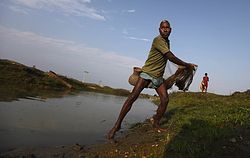In Asia, many worry that efforts to control scarce water resources will lead to serious conflicts.
By Denis D Gray
A fisherman casts his net on Feb. 19 in a river near Bahir Jonai, Assam, India. A vast and heavily populated region of Asia that depends on water from Tibetan rivers is feeling the effects of China's ambitious efforts to redraw its water map. Some even worry about future water wars, while others say there's still time for diplomacy to keep the peace.
BAHIR JONAI, India -- The wall of water raced through narrow Himalayan gorges in northeast India, gathering speed as it raked the banks of towering trees and boulders. When the torrent struck their island in the Brahmaputra river, the villagers remember, it took only moments to obliterate their houses, possessions and livestock.
No one knows exactly how the disaster happened, but everyone knows whom to blame: neighboring China.
"We don't trust the Chinese," says fisherman Akshay Sarkar at the resettlement site where he has lived since the 2000 flood. "They gave us no warning. They may do it again."
About 500 miles east, in northern Thailand, Chamlong Saengphet stands in the Mekong river, in water that comes only up to her shins. She is collecting edible river weeds from dwindling beds. A neighbor has hung up his fishing nets, his catches now too meager.
Using words bordering on curses, they point upstream, toward China.
The blame game, voiced in vulnerable river towns and Asian capitals from Pakistan to Vietnam, is rooted in fear that China's accelerating program of damming every major river flowing from the Tibetan plateau will trigger natural disasters, degrade fragile ecologies, divert vital water supplies.
A few analysts and environmental advocates even speak of water as a future trigger for war or diplomatic strong-arming, though others strongly doubt it will come to that. Still, the remapping of the water flow in the world's most heavily populated and thirstiest region is happening on a gigantic scale, with potentially strategic implications.
On the eight great Tibetan rivers alone, almost 20 dams have been built or are under construction, while some 40 more are planned or proposed.
China is hardly alone in disrupting the region's water flows. Others are doing it with potentially even worse consequences. But China's vast thirst for power and water, its control over the sources of the rivers and its ever-growing political clout make it a singular target of criticism and suspicion.
"Whether China intends to use water as a political weapon or not, it is acquiring the capability to turn off the tap if it wants to -- a leverage it can use to keep any riparian neighbors on good behavior," said Brahma Chellaney, an analyst at New Delhi's Center for Policy Research and author of the forthcoming "Water: Asia's New Battlefield."
Analyst Neil Padukone calls it "the biggest potential point of contention between the two Asian giants," China and India. But the stakes might be even higher since those eight Tibetan rivers serve a vast west-east arc of 1.8 billion people stretching from Pakistan to Vietnam's Mekong river delta.
Suspicions are heightened by Beijing's lack of transparency and refusal to share most hydrological and other data. Only China, along with Turkey, has refused to sign a key 1997 U.N. convention on transnational rivers.
Beijing gave no notice when it began building three dams on the Mekong -- the first completed in 1993 -- or the $1.2 billion Zangmu dam, the first on the mainstream of the 1,790-mile Brahmaputra which was started last November and hailed in official media as "a landmark priority project."
The 2000 flood that hit Sarkar's village, is widely believed to have been caused by the burst of an earthen dam wall on a Brahmaputra tributary. But China has kept silent.
"Until today, the Indian government has no clue about what happened," said Ravindranath, who heads the Rural Volunteer Center. He uses only one name.
Tibet's spiritual leader, the Dalai Lama, has also warned of looming dangers stemming from the Tibetan plateau.
"It's something very, very essential. So, since millions of Indians use water coming from the Himalayan glaciers... I think you (India) should express more serious concern. This is nothing to do with politics, just everybody's interests, including Chinese people," he said in New Delhi last month.
Beijing normally counters such censure by pointing out that the bulk of water from the Tibetan rivers springs from downstream tributaries, with only 13-16 percent originating in China.
Officials also say that the dams can benefit their neighbors, easing droughts and floods by regulating flow, and that hydroelectric power reduces China's carbon footprint.
China "will fully consider impacts to downstream countries," Chinese Foreign Ministry spokeswoman Jiang Yu recently told The Associated Press. "We have clarified several times that the dam being built on the Brahmaputra River has a small storage capacity. It will not have large impact on water flow or the ecological environment of downstream."
For some of China's neighbors, the problem is that they too are building controversial dams and might look hypocritical if they criticize China too loudly.
The four-nation Mekong River Commission has expressed concerns not just about the Chinese dams but about a host of others built or planned in downstream countries.
In northeast India, a broad-based movement is fighting central government plans to erect more than 160 dams in the region, and Laos and Cambodia have proposed plans for 11 Mekong dams, sparking environmental protest.
Neither the Indian nor Chinese government responded to specific questions from the AP about the dams, but Beijing is signaling that it will relaunch mega-projects after a break of several years in efforts to meet skyrocketing demands for energy and water, reduce dependence on coal and lift some 300 million people out of poverty.
Source: THE ASSOCIATED PRESS
Photo by: Altaf Qadri








0 comments:
Post a Comment